Monoblock Acer Aspire 5600U: outside, inside and under Windows 8
In May of this year, I bought a new desktop - a huge powerful laptop designed to duplicate (or even replace) a home computer in almost all forms. I chose it for a long time, and eventually settled on an 18-inch model with a FullHD-screen, a quad-core Core i7, a discrete GeForce 555 graphics card, a Blu-ray drive and even a remote control masquerading as a touchpad. In the process of buying and configuring the desktop, from time to time I shared my impressions with twitter, and several people asked me at once - why should I buy such a tombstone, if for a long time there are high-quality monoblocks? They are cheaper and take up less space, but the meaning is exactly the same.
I was still extremely pleased with the purchase, but nevertheless certain doubts were spinning in my head - how did a little goof off? Therefore, during Computex I spied several new all-in-ones on Ivy Bridge manufactured by Acer and Asus. And as soon as the first of them got to Russia, he asked his “carriage” friends for one copy for a couple of weeks to try on. They became the 23-inch candy bar Acer Aspire 5600U. According to tradition, I not only studied the device from the outside, but also dug a little inside.

A monoblock is delivered in a hefty cardboard box that you don’t especially take, even despite the presence of a convenient plastic handle. Inside lies the all-in-one, a heavy 135-watt LiteOn power supply, as well as a compact wireless keyboard and mouse. As a bonus, a weighty metal construction is attached to mount the candy bar on the wall and a remote control like a television, and on the back of the latter there was a place for a QWERTY keyboard. At first I giggled over all these accessories, but when I got acquainted with the capabilities of the candy bar, I realized that there was considerable benefit from them. However, we will not get ahead of ourselves.
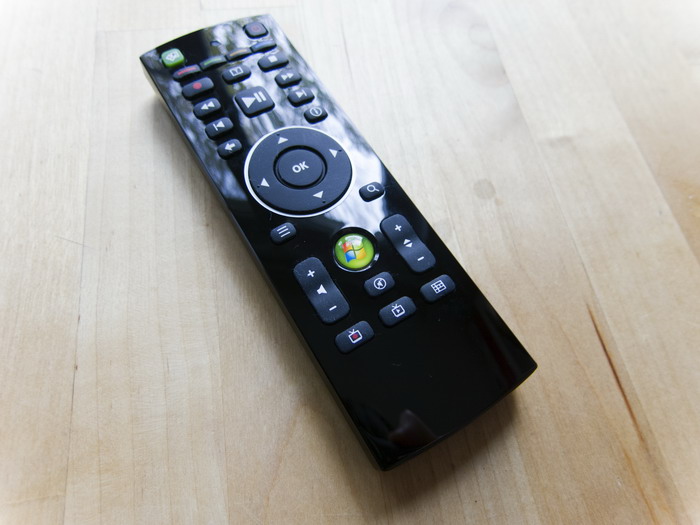
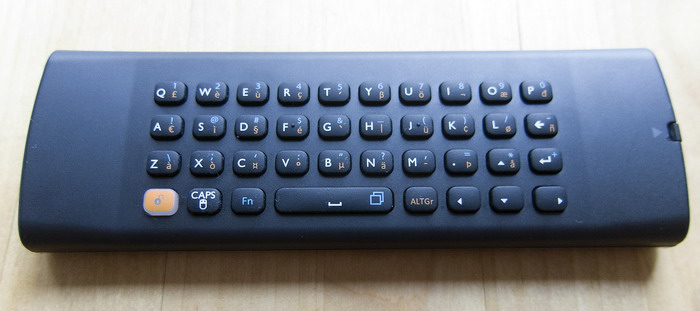
Remote control on both sides.
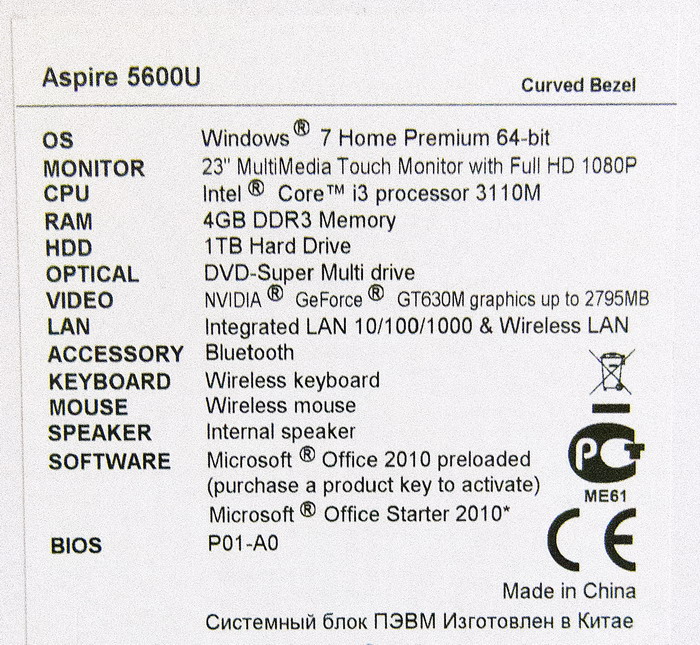
Sticker on a box with monoblock characteristics.
The 23-inch Aspire 5600U matrix has a resolution of 1920 × 1080 pixels, or, more simply, FullHD. It was made using TN + Film technology, but the color rendering quality is not much inferior to my home monitor with IPS (yes, I was surprised myself). The viewing angles, of course, are smaller (both vertically and horizontally), but they are small and not annoying. Not like my desktop, where moving the head to the right or left can significantly change the perception of the image. The response time has not been written anywhere, but, according to observations, it is low enough not to spoil the impression of games and movies. I will warn connoisseurs of radically BLACK color - he is not here, there is only a very dark gray. The LED backlight is quite uniform, and the lower left corner stands out from the rest much less,
Iron
There are several versions of the Aspire 5600U. In older (and more expensive models) there is a Core i5-3210M processor (third generation, Ivy Bridge) with a clock frequency of 2.5 GHz, which in Turbo Boost mode rises to 3.1 GHz. For experiments, they gave me the youngest model, inside which was found the Core i3-3110M with a frequency of 2.4 GHz and without any “turbo boosts” there. However, I would look at the homework, apart from the frantic installation of terabytes of video in FullHD, where even this "weakling" would not have the power. The processor is made according to 22-nanometer technology and with a large margin fits into the TDP of 35 watts. There are two cores, but there is support for Hyper-Threading (thanks that at least it wasn’t cut off in the name of emphasizing the budget of this model).

The first time I see such a funny mistake with CPU-Z! The processor model was recognized correctly, but the program chose to name it Core i5 .
In conjunction with a rather weak version of the integrated graphics core Intel HD Graphics 4000 (in the Core i5 / i7 it is much more cheerful), the Nvidia GeForce GT 630M chip is working. This is a new generation of Nvidia mobile graphics: 40-nanometer manufacturing technology, 96 universal cores, 128-bit memory bus, the last 1 GB. In terms of performance, the GeForce GT 630M is somewhere in the middle between the GeForce 540 and GeForce 555. That is - nothing special, such a normal middling. In order to appreciate that they can be paired with a processor, I put on the Acer Aspire 5600U the kind of hearted game World of Tanks (version 0.8.0). The built-in benchmark liked the system so much that in the auto-detecting mode, he set it to either high or maximum settings, depending on the mood. Alas, alas. With them, the game turned into a sad slideshow "about tanks", and even at medium settings it was possible to get only 15-17 frames per second. The real "playability" appeared only in the "Low" mode, when the FPS number grew to 25-30.
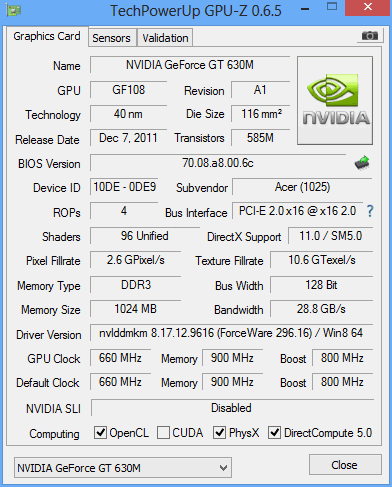
It is worth noting that WoT from the eighth version began to consume resources much more strongly, and the current “low” in the picture is quite consistent with the previous “average”. This, of course, does not make the all-in-one a powerful gaming machine, but partly rehabilitates it.
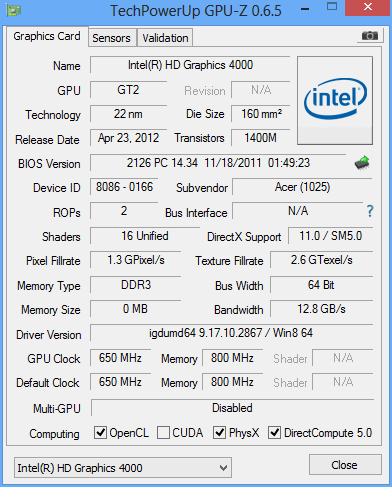
I also noticed one absurdity with the drivers. After loading the system, a version of ForceWare 296.16 was discovered, which by now is already hopelessly outdated. However, attempts to update the driver failed. The distribution downloaded from the Nvidia website stubbornly insisted that there was nothing compatible with it in the system, and finished work. The same story was repeated in a freshly installed Windows 8 (I’ll tell you about the need to check the candy bar under it a little later). On the Acer website, a working driver was found, but, unfortunately, it was the same ancient version. Perhaps when the company updates its distribution, the performance in new games will grow a bit. But the miracle, of course, is still not worth the wait.
As you probably already noticed, in a monoblock laptop iron is found very often. Yes, that is right. In fact, the system is a 23-inch monitor, to which the electronics from a mid-range laptop are attached at the back. So what else is there? Let’s finally look inside.
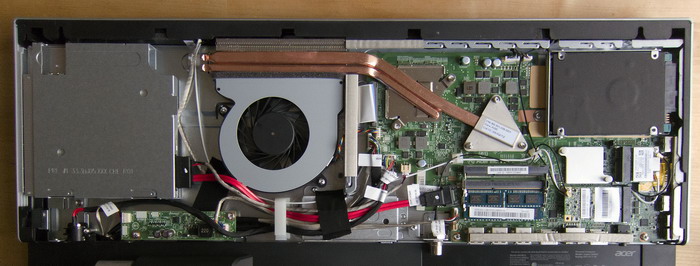
General view of the electronic filling monoblock
The volume of the hard drive for my instance was 1 TB. It is 2.5-inch, and if desired, you can upgrade to 1.5 and even 2 TB (this amount is available in the WD Green line). I was surprised that instead of the WD or Seagate traditionally found in Acer technology, the Toshiba MQ01ABD100 (5400 RPM, SATA-II) works here. Toshiba is still alive so she is healthy! The disk behaves very quietly, the speed is typical for models with such an RPM. Some sources claim that in the vicinity of the hard drive lives an SSD of 20 GB, designed to speed up the system. So in my version of the candy bar it is not, this is a feature of more expensive trim levels. However, the computer still responds to commands very quickly, especially if you tear down the pre-installed McAfee antivirus software.
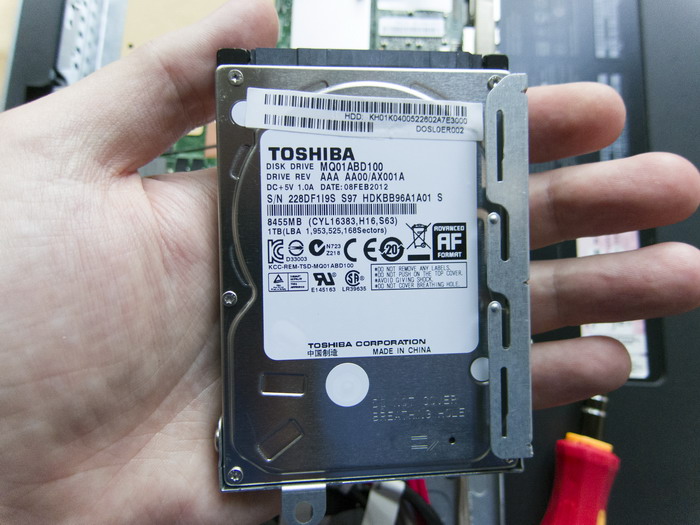
The amount of RAM is 4 GB, it is installed by one module, and there is a free slot nearby. So to finish up to 8 GB is not a problem at all, but it is possible to 16, if the soul asks.
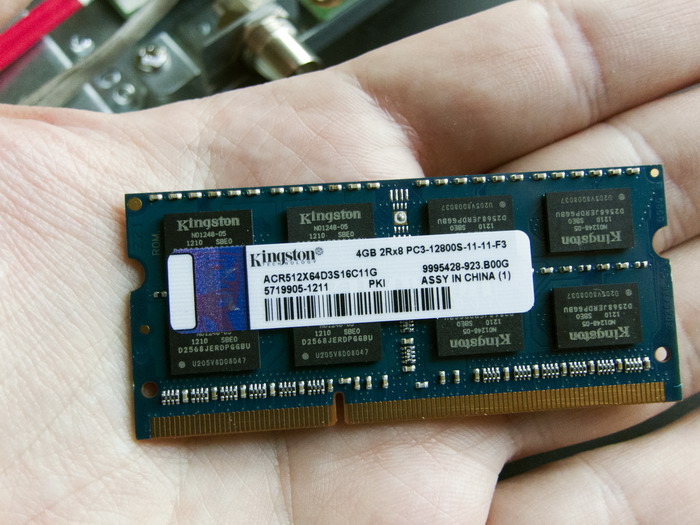
Next to the memory lives the TV tuner AVerMedia A373 with support for the DVB-T standard. Of course, you can connect an ordinary collective antenna, which dramatically increases the meaning of mounting the Aspire 5600U on the wall. Of course, the diagonal is not enough for a large room, but, for example, for a student’s cell, it’s pretty decent. Moreover, the HDMI port of the monoblock works not only outward, but also inward. And accordingly, a variety of devices can be connected to it, from a media player to a game console.

The Atheros adapter, with the traditionally musical and catchy name AR5B22, combines WiFi and Bluetooth support. Its advantages include support for the 2.4- and 5-gigahertz ranges of WiFi, which makes it almost guaranteed to find a channel that is not too littered (unfortunately, in high-rise buildings it is becoming more and more difficult). Of the shortcomings, only the inability to work with Intel WiDi technology (wireless display), but, honestly, in this case it is not very necessary.
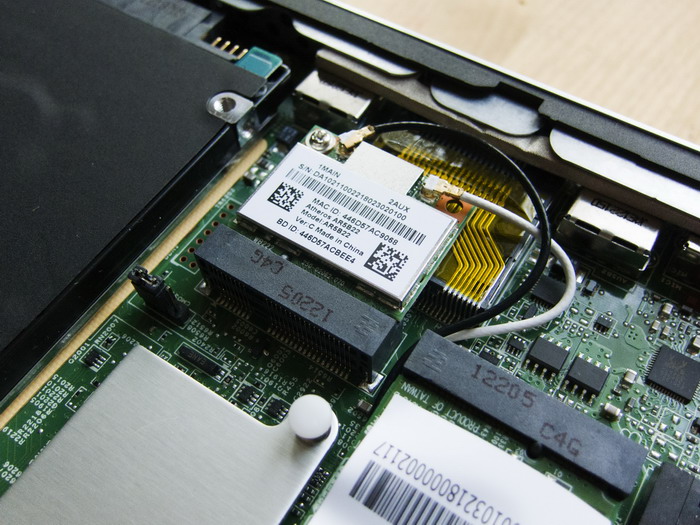
A separate compliment to the cooling system: it is very, very quiet. Even under good load, the only turbine is not heard at all. The propeller itself is made by Sunon, a company very beloved by manufacturers of ultrabooks.
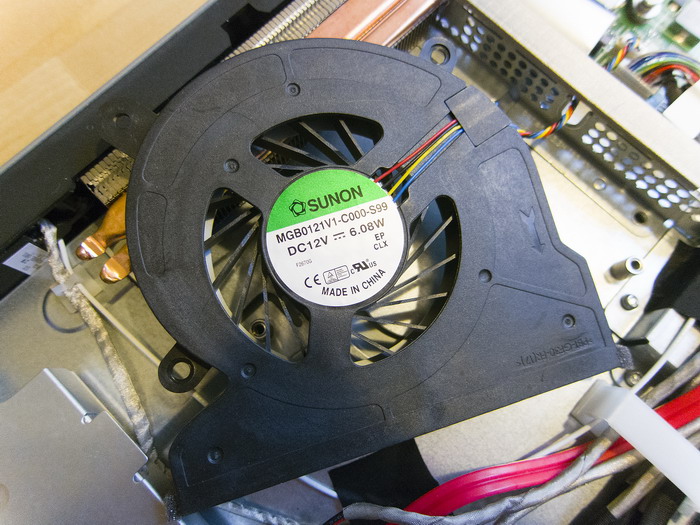
The iron part of the cooling system was developed by Acer itself, and does not stand out anything special, except for the very, very thin fins of the radiator, which literally bend under the fingers.
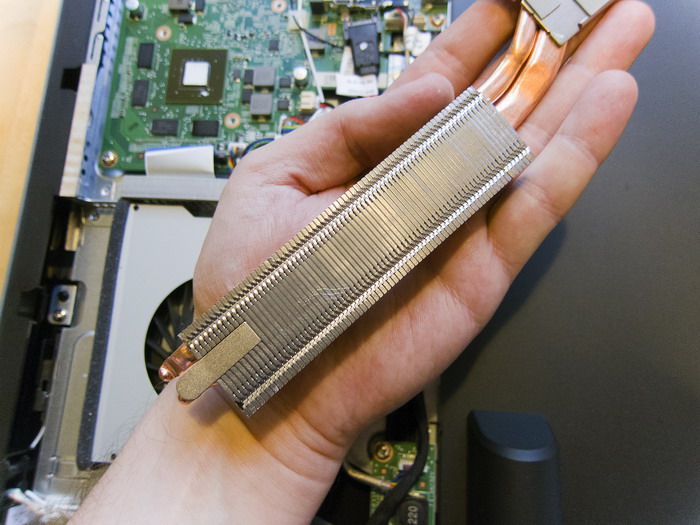
They are also located very tightly to each other, and over time, the radiator can become clogged with dust. Fortunately, the monoblock is disassembled in an elementary way, and full cleaning can be carried out even at home, if you are not afraid to unscrew the two screws on the Aspire 5600U body and five on the cooling system. At the same time, lubricate the graphics chip and the processor with a new portion of thermal paste, it will not hurt.
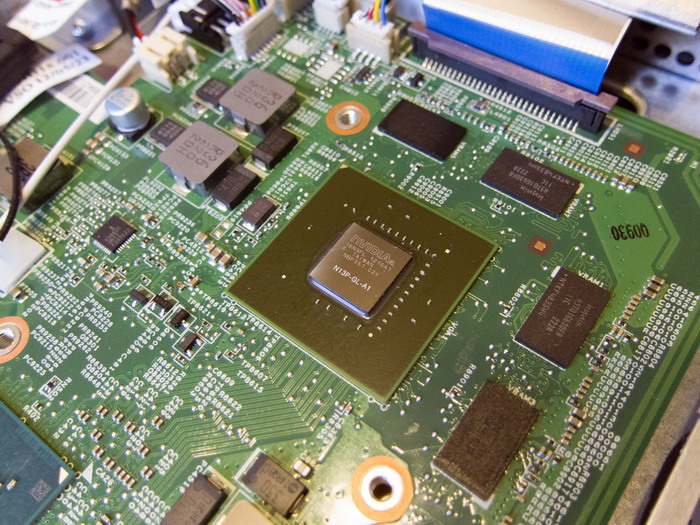
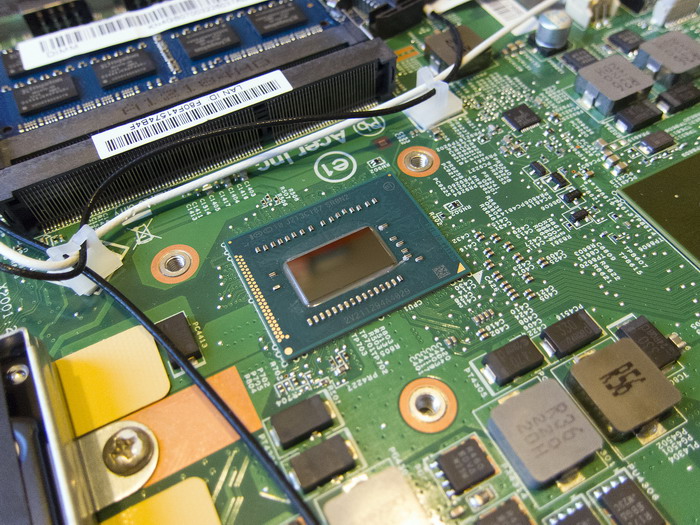
Naked graphics chip and processor
Concluding my acquaintance with the iron part, I’ll add that the all-in-one has five USB ports, two of which support the 3.0 standard. They are located reasonably: the two fastest on the left side, and the rest on the back. Also on the case there is a multi-format card reader slot and a webcam. You don’t have to be surprised - it's a laptop platform, and a set of buns is pretty standard.
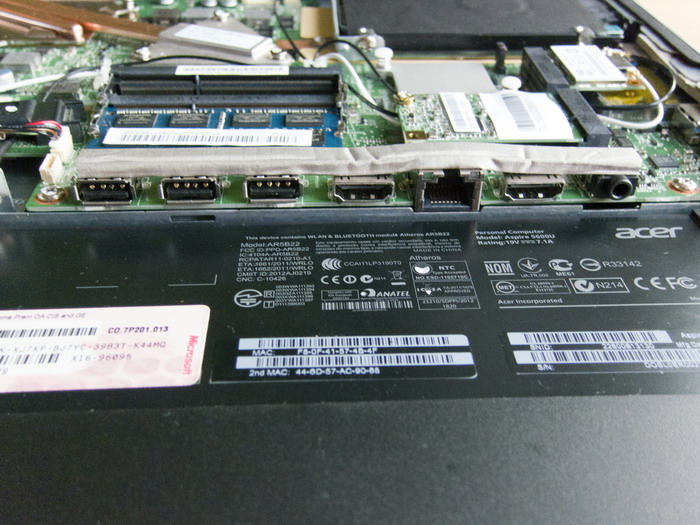
A set of connectors on the back of the candy bar
In general, from an iron standpoint, this candy bar is a typical representative of the middle class with a slight aftertaste of budget. Somewhat surprisingly, the lack of support in the optical drive format Blu-ray ... But, on the other hand, I have it in the desktop, but the Blu-ray discs are not at home and are not expected. It seems that their time is over, so plainly and not starting.
Come, Mikhalych, touch your hand ...
And now is the time to remember the main "chip" of this model. At the beginning of the story, I deliberately did not specify that the screen at the monoblock has a shiny glass coating. In this case, it is not present to annoy the glossy haters, but because of a much more respectful reason. After all, the screen of the Aspire 5600U is touch-sensitive, with Milti-touch support and processing up to ten clicks at a time.
That's just under Windows 7, with which the all-in-one comes at the moment, there’s no use from this. No, you can, of course, effectively poke your finger into the Start button and they can easily run Excel. Probably, the girls will like this sight, but with the mouse - it is somehow faster and more convenient. Therefore, in order to experience the delight of the touch screen in full, I installed the final version of Windows 8 on a candy bar, sent to me by an old friend Steve B.

Portrait of Steve B. of my work
Along with the distribution, Steve also sent me a megaflash with Windows To Go installed on it. The thing, by the way, is archipolous - you can not take a laptop with you on the road, but confine yourself to such a flash drive. You insert it into any computer that has turned up, once, and you have before your eyes your personal copy of Windows 8 with the usual set of programs. I did this focus many times on different systems, but for some reason the Aspire 5600U did not work out. At the same place, a message came out about a total misunderstanding between the OS and the hardware, after which an inevitable reboot occurred. After suffering about fifteen minutes, I decided to roll Windows 8 onto the hard drive itself, and then everything went perfectly. The G8 got up in a few minutes, asked for a WiFi adapter driver, after which it sucked up almost all the other drivers with updates and offered to get started.
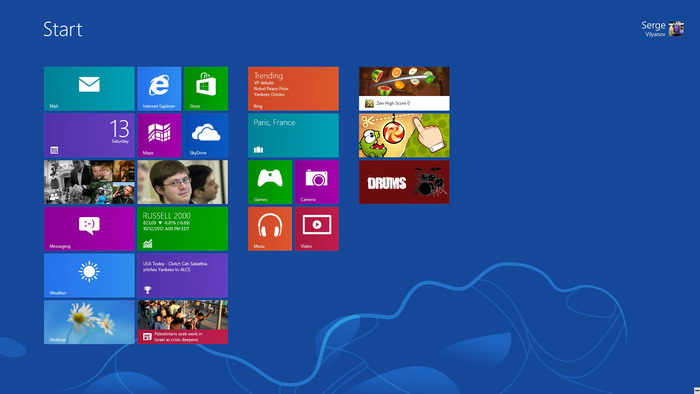
And here it is - the Windows 8 interface that we have been taught to call Metro for so long. I admit right away that I have been using the G8 on my tablet computer since June, and so the enthusiasm for the pretty moving tiles has long been over. And in general, I have a lot of questions for this brainchild of Microsoft, but about them, probably, in a separate post.
On the tablet, the new interface is, of course, extremely useful. On a desktop computer, where there is a hardware keyboard and mouse, everything is not so obvious, but, perhaps, it’s more convenient for me to open the weather forecast and flip through the news with my finger. The same story with paging photos and switching to the desired fragment in the video - the finger is much more agile. I’m not sure that for the sake of this it is worth throwing your “non-touch” monitor in the trash or changing the laptop, but - it's cool.
But who the big touch screen really will please is the children. Testing of the Aspire 5600U under the G8 took place at the time when we stayed at home alone with a four-year-old son. And you would have seen his reaction when he saw on the huge screen familiar to him from the tablet Cut The Rope and - especially - Fruit Ninja. His enthusiasm cannot be described in words. Wow, bright fruits fly around the screen, the size of a children's fist, and they can be crumbled with both hands! And how good the eater of flying candies is at 23 inches! It's great to play virtual drums, while at the same time beating fingers with six to seven varieties!

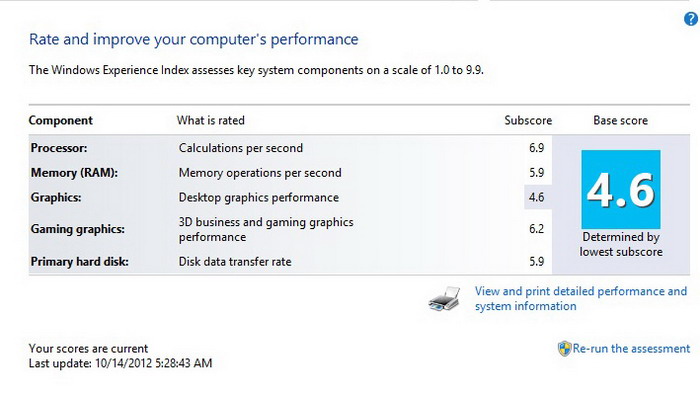
For some reason, Windows 7 (above) thinks about the graphic component of the candy bar slightly better than Windows 8 (below)
After the games, I launched online maps, and the child was extremely interested in how the surroundings of the house look from above. They can be zoomed in, removed, and also twisted in different directions with both hands, and in children's eyes it looks like a kind of magic. Inquiries were received to show a kindergarten, a park, a pool and my place of work. And for dessert, we still turned and turned the panoramas of different cities from the standard “Travel” application for Windows 8.
And after that I began to relate to touch interfaces on desktop computers with much greater understanding and sympathy. It’s unlikely that I have enough drive to upgrade my home computer and laptops in the name of Multi-touch support, and my child will chop down his apples and pineapples on a 13-inch tablet with a figure of eight. But in the future, if the price difference between the touch and non-touch screen is small, I will definitely choose the first one.
It is a pity that Windows 8 itself can still be considered suitable for full touch control only very conditionally. In Desktop mode, where the vast majority of really needed applications are still running, poking your finger is completely pointless. And it’s less convenient to control the mouse than under Windows 7. It is not in vain that the utility that returns the Start button has already become the most popular application for the G8.
Lyrical digression
Before proceeding to the conclusions, I want to briefly describe my model of using the desktop and home computer. They almost always stand nearby - a desktop (Acer Aspire 8951G) on the table, and a large computer - under the table. The image from the latter is displayed on a 23-inch monitor with an IPS matrix.
Most of the time I work on the desktop. Typing, rough processing of photos and videos, Internet surfing, correspondence, short rides in World of Tanks - that's all on it. I really like that you can work at high speed and on a rather large 18-inch screen without worrying about data safety (there are two hardy in the system), electricity blinks (battery lasts for 6 hours) and easily moves from room to room. Yes, and the willingness to work a few seconds after lifting the lid ... captivating.
But when I need serious performance and / or high-quality picture, I turn on the big computer. It has a fairly serious configuration - Core i7 Extreme Edition, GeForce GTX 670, 12 GB of memory, a fast SSD for the operating system and WD Velociraptor for data. So the final processing of large volumes of images and videos, as well as really beautiful games, is only on it. But writing texts on such a monster is somehow inconvenient. All the same, that on a real frame SUV to carry a lap-dog on a pedicure.
And now - to the conclusions about the Acer all-in-one.
Total
I really liked that to get started, the Acer Aspire 5600U just needs to be plugged in. No need to bother with the cables, the mouse and keyboard will pick up themselves (they did not require drivers even after installing Windows 8 from scratch), entered the WiFi password - and it started. Monoblock is quite easily transferred from room to room, if only in a new place there was a flat surface of sufficient area. When mounting on the wall, you can save a lot of space on the table (thickness, or rather, thinness of the case in the thickest place - 35 mm). A well-thought-out cooling system will not annoy the owner with its sounds (the desktop, to be honest, is sometimes annoying). Finally, the device looks very nice and modern, which makes it a kind of decoration of the room.

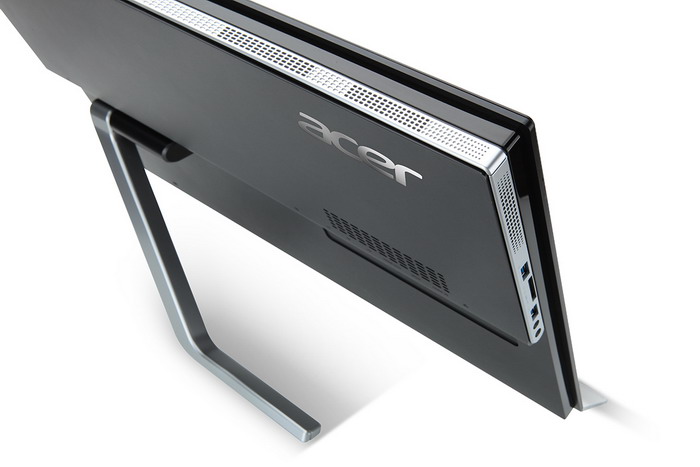
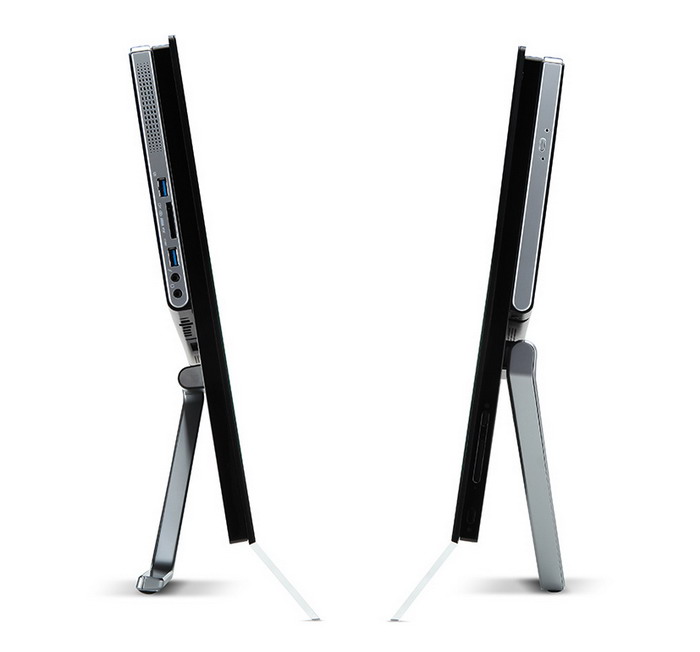
Could he fit into my life, replacing both the desktop and the large computer? Yes, but with three important caveats.
Firstly, it should have a screen with an IPS or * VA matrix. Due to the nature of the work, I cannot do without it.
Secondly, I need a much more powerful graphics card. Game developers seem to have moderated their appetites, and the Nvidia / AMD desktop solutions that belong to the upper middle level (or more precisely?) Are usually enough for me to see all (well, almost all) the beauties of new toys. But mobile chips are still not close to them, alas.
Thirdly, the built-in battery would not hurt. Let a small capacity, capable of powering the system for no more than half an hour, but that was. You can, of course, connect the all-in-one to the UPS, but since there is a completely laptop platform in it - why not add this element?
These are my needs. I’m not sure what the typical ones are - but which ones already exist.
If you rarely process photos for publication in a magazine, and treat games with extreme restraint, a candy bar is a great choice for you. So, I would love to give the Aspire 5600U to my parents - for them, this “thing in itself” is much better than the current “just a computer”.
But for this you need to be a pretty wealthy guy. My version of the candy bar in retail costs from 35,000 rubles. A copy with a Core i5 and “accelerating” SSD will cost about 40 thousand. Finally, for 45 thousand you can buy the Aspire 5600U with the above buns and 8 gigabytes of RAM in addition, although I will not recommend this option. Two 8 GB modules now cost less than three thousand, and paying five for a 4 GB one is completely absurd.
Yes, and I have a feeling that in a couple of years under home computers we will mean exactly monoblocks.
I was still extremely pleased with the purchase, but nevertheless certain doubts were spinning in my head - how did a little goof off? Therefore, during Computex I spied several new all-in-ones on Ivy Bridge manufactured by Acer and Asus. And as soon as the first of them got to Russia, he asked his “carriage” friends for one copy for a couple of weeks to try on. They became the 23-inch candy bar Acer Aspire 5600U. According to tradition, I not only studied the device from the outside, but also dug a little inside.

A monoblock is delivered in a hefty cardboard box that you don’t especially take, even despite the presence of a convenient plastic handle. Inside lies the all-in-one, a heavy 135-watt LiteOn power supply, as well as a compact wireless keyboard and mouse. As a bonus, a weighty metal construction is attached to mount the candy bar on the wall and a remote control like a television, and on the back of the latter there was a place for a QWERTY keyboard. At first I giggled over all these accessories, but when I got acquainted with the capabilities of the candy bar, I realized that there was considerable benefit from them. However, we will not get ahead of ourselves.


Remote control on both sides.

Sticker on a box with monoblock characteristics.
The 23-inch Aspire 5600U matrix has a resolution of 1920 × 1080 pixels, or, more simply, FullHD. It was made using TN + Film technology, but the color rendering quality is not much inferior to my home monitor with IPS (yes, I was surprised myself). The viewing angles, of course, are smaller (both vertically and horizontally), but they are small and not annoying. Not like my desktop, where moving the head to the right or left can significantly change the perception of the image. The response time has not been written anywhere, but, according to observations, it is low enough not to spoil the impression of games and movies. I will warn connoisseurs of radically BLACK color - he is not here, there is only a very dark gray. The LED backlight is quite uniform, and the lower left corner stands out from the rest much less,
Iron
There are several versions of the Aspire 5600U. In older (and more expensive models) there is a Core i5-3210M processor (third generation, Ivy Bridge) with a clock frequency of 2.5 GHz, which in Turbo Boost mode rises to 3.1 GHz. For experiments, they gave me the youngest model, inside which was found the Core i3-3110M with a frequency of 2.4 GHz and without any “turbo boosts” there. However, I would look at the homework, apart from the frantic installation of terabytes of video in FullHD, where even this "weakling" would not have the power. The processor is made according to 22-nanometer technology and with a large margin fits into the TDP of 35 watts. There are two cores, but there is support for Hyper-Threading (thanks that at least it wasn’t cut off in the name of emphasizing the budget of this model).

The first time I see such a funny mistake with CPU-Z! The processor model was recognized correctly, but the program chose to name it Core i5 .
In conjunction with a rather weak version of the integrated graphics core Intel HD Graphics 4000 (in the Core i5 / i7 it is much more cheerful), the Nvidia GeForce GT 630M chip is working. This is a new generation of Nvidia mobile graphics: 40-nanometer manufacturing technology, 96 universal cores, 128-bit memory bus, the last 1 GB. In terms of performance, the GeForce GT 630M is somewhere in the middle between the GeForce 540 and GeForce 555. That is - nothing special, such a normal middling. In order to appreciate that they can be paired with a processor, I put on the Acer Aspire 5600U the kind of hearted game World of Tanks (version 0.8.0). The built-in benchmark liked the system so much that in the auto-detecting mode, he set it to either high or maximum settings, depending on the mood. Alas, alas. With them, the game turned into a sad slideshow "about tanks", and even at medium settings it was possible to get only 15-17 frames per second. The real "playability" appeared only in the "Low" mode, when the FPS number grew to 25-30.

It is worth noting that WoT from the eighth version began to consume resources much more strongly, and the current “low” in the picture is quite consistent with the previous “average”. This, of course, does not make the all-in-one a powerful gaming machine, but partly rehabilitates it.

I also noticed one absurdity with the drivers. After loading the system, a version of ForceWare 296.16 was discovered, which by now is already hopelessly outdated. However, attempts to update the driver failed. The distribution downloaded from the Nvidia website stubbornly insisted that there was nothing compatible with it in the system, and finished work. The same story was repeated in a freshly installed Windows 8 (I’ll tell you about the need to check the candy bar under it a little later). On the Acer website, a working driver was found, but, unfortunately, it was the same ancient version. Perhaps when the company updates its distribution, the performance in new games will grow a bit. But the miracle, of course, is still not worth the wait.
As you probably already noticed, in a monoblock laptop iron is found very often. Yes, that is right. In fact, the system is a 23-inch monitor, to which the electronics from a mid-range laptop are attached at the back. So what else is there? Let’s finally look inside.

General view of the electronic filling monoblock
The volume of the hard drive for my instance was 1 TB. It is 2.5-inch, and if desired, you can upgrade to 1.5 and even 2 TB (this amount is available in the WD Green line). I was surprised that instead of the WD or Seagate traditionally found in Acer technology, the Toshiba MQ01ABD100 (5400 RPM, SATA-II) works here. Toshiba is still alive so she is healthy! The disk behaves very quietly, the speed is typical for models with such an RPM. Some sources claim that in the vicinity of the hard drive lives an SSD of 20 GB, designed to speed up the system. So in my version of the candy bar it is not, this is a feature of more expensive trim levels. However, the computer still responds to commands very quickly, especially if you tear down the pre-installed McAfee antivirus software.

The amount of RAM is 4 GB, it is installed by one module, and there is a free slot nearby. So to finish up to 8 GB is not a problem at all, but it is possible to 16, if the soul asks.

Next to the memory lives the TV tuner AVerMedia A373 with support for the DVB-T standard. Of course, you can connect an ordinary collective antenna, which dramatically increases the meaning of mounting the Aspire 5600U on the wall. Of course, the diagonal is not enough for a large room, but, for example, for a student’s cell, it’s pretty decent. Moreover, the HDMI port of the monoblock works not only outward, but also inward. And accordingly, a variety of devices can be connected to it, from a media player to a game console.

The Atheros adapter, with the traditionally musical and catchy name AR5B22, combines WiFi and Bluetooth support. Its advantages include support for the 2.4- and 5-gigahertz ranges of WiFi, which makes it almost guaranteed to find a channel that is not too littered (unfortunately, in high-rise buildings it is becoming more and more difficult). Of the shortcomings, only the inability to work with Intel WiDi technology (wireless display), but, honestly, in this case it is not very necessary.

A separate compliment to the cooling system: it is very, very quiet. Even under good load, the only turbine is not heard at all. The propeller itself is made by Sunon, a company very beloved by manufacturers of ultrabooks.

The iron part of the cooling system was developed by Acer itself, and does not stand out anything special, except for the very, very thin fins of the radiator, which literally bend under the fingers.

They are also located very tightly to each other, and over time, the radiator can become clogged with dust. Fortunately, the monoblock is disassembled in an elementary way, and full cleaning can be carried out even at home, if you are not afraid to unscrew the two screws on the Aspire 5600U body and five on the cooling system. At the same time, lubricate the graphics chip and the processor with a new portion of thermal paste, it will not hurt.


Naked graphics chip and processor
Concluding my acquaintance with the iron part, I’ll add that the all-in-one has five USB ports, two of which support the 3.0 standard. They are located reasonably: the two fastest on the left side, and the rest on the back. Also on the case there is a multi-format card reader slot and a webcam. You don’t have to be surprised - it's a laptop platform, and a set of buns is pretty standard.

A set of connectors on the back of the candy bar
In general, from an iron standpoint, this candy bar is a typical representative of the middle class with a slight aftertaste of budget. Somewhat surprisingly, the lack of support in the optical drive format Blu-ray ... But, on the other hand, I have it in the desktop, but the Blu-ray discs are not at home and are not expected. It seems that their time is over, so plainly and not starting.
Come, Mikhalych, touch your hand ...
And now is the time to remember the main "chip" of this model. At the beginning of the story, I deliberately did not specify that the screen at the monoblock has a shiny glass coating. In this case, it is not present to annoy the glossy haters, but because of a much more respectful reason. After all, the screen of the Aspire 5600U is touch-sensitive, with Milti-touch support and processing up to ten clicks at a time.
That's just under Windows 7, with which the all-in-one comes at the moment, there’s no use from this. No, you can, of course, effectively poke your finger into the Start button and they can easily run Excel. Probably, the girls will like this sight, but with the mouse - it is somehow faster and more convenient. Therefore, in order to experience the delight of the touch screen in full, I installed the final version of Windows 8 on a candy bar, sent to me by an old friend Steve B.

Portrait of Steve B. of my work
Along with the distribution, Steve also sent me a megaflash with Windows To Go installed on it. The thing, by the way, is archipolous - you can not take a laptop with you on the road, but confine yourself to such a flash drive. You insert it into any computer that has turned up, once, and you have before your eyes your personal copy of Windows 8 with the usual set of programs. I did this focus many times on different systems, but for some reason the Aspire 5600U did not work out. At the same place, a message came out about a total misunderstanding between the OS and the hardware, after which an inevitable reboot occurred. After suffering about fifteen minutes, I decided to roll Windows 8 onto the hard drive itself, and then everything went perfectly. The G8 got up in a few minutes, asked for a WiFi adapter driver, after which it sucked up almost all the other drivers with updates and offered to get started.

And here it is - the Windows 8 interface that we have been taught to call Metro for so long. I admit right away that I have been using the G8 on my tablet computer since June, and so the enthusiasm for the pretty moving tiles has long been over. And in general, I have a lot of questions for this brainchild of Microsoft, but about them, probably, in a separate post.
On the tablet, the new interface is, of course, extremely useful. On a desktop computer, where there is a hardware keyboard and mouse, everything is not so obvious, but, perhaps, it’s more convenient for me to open the weather forecast and flip through the news with my finger. The same story with paging photos and switching to the desired fragment in the video - the finger is much more agile. I’m not sure that for the sake of this it is worth throwing your “non-touch” monitor in the trash or changing the laptop, but - it's cool.
But who the big touch screen really will please is the children. Testing of the Aspire 5600U under the G8 took place at the time when we stayed at home alone with a four-year-old son. And you would have seen his reaction when he saw on the huge screen familiar to him from the tablet Cut The Rope and - especially - Fruit Ninja. His enthusiasm cannot be described in words. Wow, bright fruits fly around the screen, the size of a children's fist, and they can be crumbled with both hands! And how good the eater of flying candies is at 23 inches! It's great to play virtual drums, while at the same time beating fingers with six to seven varieties!


For some reason, Windows 7 (above) thinks about the graphic component of the candy bar slightly better than Windows 8 (below)
After the games, I launched online maps, and the child was extremely interested in how the surroundings of the house look from above. They can be zoomed in, removed, and also twisted in different directions with both hands, and in children's eyes it looks like a kind of magic. Inquiries were received to show a kindergarten, a park, a pool and my place of work. And for dessert, we still turned and turned the panoramas of different cities from the standard “Travel” application for Windows 8.
And after that I began to relate to touch interfaces on desktop computers with much greater understanding and sympathy. It’s unlikely that I have enough drive to upgrade my home computer and laptops in the name of Multi-touch support, and my child will chop down his apples and pineapples on a 13-inch tablet with a figure of eight. But in the future, if the price difference between the touch and non-touch screen is small, I will definitely choose the first one.
It is a pity that Windows 8 itself can still be considered suitable for full touch control only very conditionally. In Desktop mode, where the vast majority of really needed applications are still running, poking your finger is completely pointless. And it’s less convenient to control the mouse than under Windows 7. It is not in vain that the utility that returns the Start button has already become the most popular application for the G8.
Lyrical digression
Before proceeding to the conclusions, I want to briefly describe my model of using the desktop and home computer. They almost always stand nearby - a desktop (Acer Aspire 8951G) on the table, and a large computer - under the table. The image from the latter is displayed on a 23-inch monitor with an IPS matrix.
Most of the time I work on the desktop. Typing, rough processing of photos and videos, Internet surfing, correspondence, short rides in World of Tanks - that's all on it. I really like that you can work at high speed and on a rather large 18-inch screen without worrying about data safety (there are two hardy in the system), electricity blinks (battery lasts for 6 hours) and easily moves from room to room. Yes, and the willingness to work a few seconds after lifting the lid ... captivating.
But when I need serious performance and / or high-quality picture, I turn on the big computer. It has a fairly serious configuration - Core i7 Extreme Edition, GeForce GTX 670, 12 GB of memory, a fast SSD for the operating system and WD Velociraptor for data. So the final processing of large volumes of images and videos, as well as really beautiful games, is only on it. But writing texts on such a monster is somehow inconvenient. All the same, that on a real frame SUV to carry a lap-dog on a pedicure.
And now - to the conclusions about the Acer all-in-one.
Total
I really liked that to get started, the Acer Aspire 5600U just needs to be plugged in. No need to bother with the cables, the mouse and keyboard will pick up themselves (they did not require drivers even after installing Windows 8 from scratch), entered the WiFi password - and it started. Monoblock is quite easily transferred from room to room, if only in a new place there was a flat surface of sufficient area. When mounting on the wall, you can save a lot of space on the table (thickness, or rather, thinness of the case in the thickest place - 35 mm). A well-thought-out cooling system will not annoy the owner with its sounds (the desktop, to be honest, is sometimes annoying). Finally, the device looks very nice and modern, which makes it a kind of decoration of the room.



Could he fit into my life, replacing both the desktop and the large computer? Yes, but with three important caveats.
Firstly, it should have a screen with an IPS or * VA matrix. Due to the nature of the work, I cannot do without it.
Secondly, I need a much more powerful graphics card. Game developers seem to have moderated their appetites, and the Nvidia / AMD desktop solutions that belong to the upper middle level (or more precisely?) Are usually enough for me to see all (well, almost all) the beauties of new toys. But mobile chips are still not close to them, alas.
Thirdly, the built-in battery would not hurt. Let a small capacity, capable of powering the system for no more than half an hour, but that was. You can, of course, connect the all-in-one to the UPS, but since there is a completely laptop platform in it - why not add this element?
These are my needs. I’m not sure what the typical ones are - but which ones already exist.
If you rarely process photos for publication in a magazine, and treat games with extreme restraint, a candy bar is a great choice for you. So, I would love to give the Aspire 5600U to my parents - for them, this “thing in itself” is much better than the current “just a computer”.
But for this you need to be a pretty wealthy guy. My version of the candy bar in retail costs from 35,000 rubles. A copy with a Core i5 and “accelerating” SSD will cost about 40 thousand. Finally, for 45 thousand you can buy the Aspire 5600U with the above buns and 8 gigabytes of RAM in addition, although I will not recommend this option. Two 8 GB modules now cost less than three thousand, and paying five for a 4 GB one is completely absurd.
Yes, and I have a feeling that in a couple of years under home computers we will mean exactly monoblocks.
